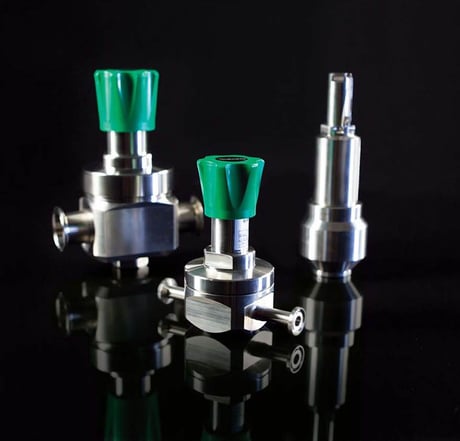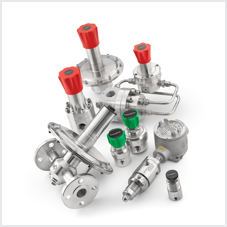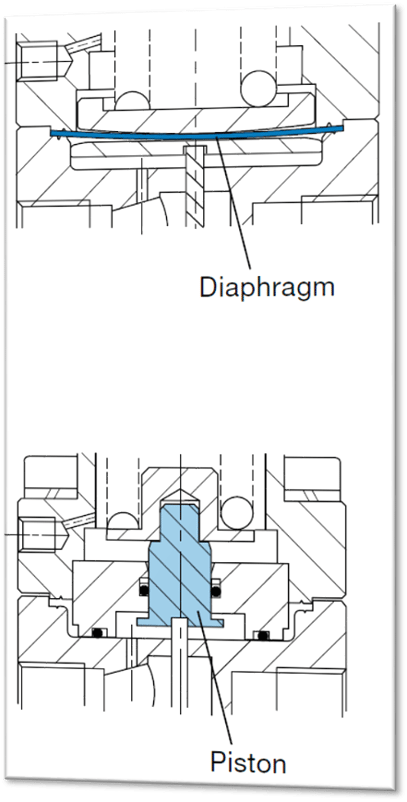Share this
Which Pressure Regulator Should You Choose for Corrosive Applications?
by Jeff Hopkins on 10/23/19 9:00 AM
Even within a given type of regulator, there are options that make big differences
"Regulators are highly technical, highly specialized fluid handling components. So, the next time you need one please do not just grab one out of the supply cabinet and install it with the vague sense that it will work."
- From Choosing The Proper Regulator For Applications With Corrosive Fluids Or Aggressive Environments
In any application with even the smallest mix of corrosive gases or liquids or aggressive environmental conditions, you should consider using a stainless steel pressure regulator. But that's only the start of the process. There are several types of regulator, and within each classification there are additional choices, such as piston versus diaphragm, and whether you want a two-stage regulator or a one-stage regulator. Even then, it's wise to consider the materials used in critical components, such as the diaphragm and the poppet seat.

Three basic types
Let's start with the basic choice in pressure regulators. Most common applications require a pressure-reducing regulator, which drops the inlet pressure to a relatively constant outlet pressure.
In some cases, the reverse may be required. That is, a back-pressure regulator would be used to mechanically control the outlet pressure, so that a relatively constant pressure is maintained at the inlet.
There's also a third option, which is a vaporizing regulator. This is a pressure-reducing regulator used either to prevent a phase change or to induce one. The regulator uses a steam or electric heating element so that the regulator won't freeze up if a rapid pressure drop causes a gas to lose a large amount of heat. In other cases, the heat is applied to vaporize a liquid for analysis, typically in a gas chromatograph.
One- or two-stage?
 One-stage pressure-reducing regulators are sufficient in most applications where the inlet pressure is relatively constant.
One-stage pressure-reducing regulators are sufficient in most applications where the inlet pressure is relatively constant.
A two-stage regulator combines two one-stage regulators
in series. The first regulator reduces the high-pressure supply to an intermediate point, then the second regulator reduces the intermediate pressure to the desired outlet pressure.
While a two-stage regulator is handy, two one-stage regulators may work just as well or better in some applications. One example is a cross-over arrangement, where two gas cylinders feed one point of entry, with one-stage regulators located off each cylinder. One cylinder is used until its pressure drops below a certain point; then, the other cylinder starts to be used. An additional regulator (often referred to as a line regulator) is located at the entry point to the system, so at all times the gas is passing through two regulators.
Diaphragm or piston?
 Diaphragm regulators generally are the most sensitive to changes in pressure, especially in low-pressure applications.
Diaphragm regulators generally are the most sensitive to changes in pressure, especially in low-pressure applications.
In a diaphragm regulator, a thin metal diaphragm flexes as the high-pressure inlet varies. The flexing causes the regulator poppet to move in and out of the regulator seat, keeping the downstream pressure constant. As inlet pressure rises, the diaphragm flexes up, which allows the poppet to rise into the seat and reduces the effect of the increasing inlet pressure. As the inlet pressure drops, the force on the diaphragm is reduced so that it flexes down and pushes the poppet out of the seat. This action allows for an increase in flow through the regulator to stabilize pressure at the outlet.
Piston regulators are generally used in higher pressure applications although they may also be used at lower pressures. In a piston regulator, pressure is controlled by means of a spring-loaded piston, which is a cylindrical metal component that is placed in the vertical cylinder of the regulator. The piston seals against the cylinder walls by means of an O-ring. The thickness of the piston, along with the O-ring seal, allows a piston regulator to achieve higher working pressures than diaphragm regulators.
The operation of a piston regulator is very similar to that of a diaphragm regulator. Adjusting the knob to achieve a higher outlet pressure causes the piston to push down on the poppet, which moves it out of the seat and creates a higher outlet pressure.
“Droop” and “Creep”
“Droop” and “creep” are two undesirable conditions. Droop occurs when more flow is required at the outlet than the regulator can provide. Creep occurs when the poppet or diaphragm is in the closed position, yet the seat allows pressure to escape to the outlet side. It generally occurs because the seat may have been damaged, contaminated or eroded.
Materials of Selection
With stainless steel regulators for high-purity applications, particular attention should be paid to the materials of construction. For the diaphragm, 316 stainless steel may not be sufficient, and an alloy such as X-750 may be more appropriate.
Likewise, the poppet seat is critical. A harder fluoropolymer is not as forgiving and will not seat as well as a softer material. On the other hand, the harder material will be more resistant to abrasion.
Once you've decided on the type of regulator you need, pay close attention to its construction, including the quality of the shell seal, ease of stem adjustment, diaphragm/piston seal, integral filtration, and poppet seating.
As always, the staff at Swagelok Northern California is glad to explain the inner workings of any of our regulators so that you can make the most educated decision. You can even request a consultation with our pressure regulator specialist.
If you'd like a more detailed look at the subject in the meantime, download this article by Bill Menz, General Manager, Swagelok Hose Services Group.
Just ask
Swagelok Northern California has a great deal of exposure to all aspects of fluid system design and engineering. Whether you have a simple question or a complex challenge, we're glad to hear from you.
Additional Resources
- Download Swagelok Pressure Regulator Catalogs (product page)
- Swagelok Pressure Regulator Assemblies (download page)
- Q&A: Answers to 5 pressure regulator questions (blog)
Share this
- Archive (465)
- Assembly Services (207)
- About (100)
- Seal Support Systems (96)
- Best Practices (88)
- Training Services (74)
- Fittings (51)
- Semiconductor Applications (49)
- Hoses and Flexible Tubing (47)
- Regulators (44)
- Tubing (42)
- Grab Sampling Systems (32)
- Sampling Systems (32)
- Gas Systems (30)
- Services (30)
- Downloads (29)
- Valves (24)
- Application Support (18)
- Orbital Welding (17)
- Case Studies (13)
- Steam Systems (13)
- Frequently Asked Questions (12)
- Tools (12)
- Measurement Devices (7)
- Subsystems (6)
- Thermal Management (6)
- September 2023 (1)
- August 2023 (2)
- June 2023 (1)
- March 2023 (3)
- February 2023 (3)
- January 2023 (4)
- December 2022 (4)
- November 2022 (4)
- October 2022 (4)
- September 2022 (1)
- August 2022 (3)
- July 2022 (2)
- June 2022 (4)
- May 2022 (1)
- April 2022 (2)
- March 2022 (1)
- February 2022 (2)
- January 2022 (3)
- December 2021 (1)
- November 2021 (6)
- October 2021 (6)
- September 2021 (8)
- August 2021 (4)
- July 2021 (3)
- June 2021 (6)
- May 2021 (6)
- April 2021 (7)
- March 2021 (5)
- February 2021 (4)
- January 2021 (6)
- December 2020 (5)
- November 2020 (6)
- October 2020 (6)
- September 2020 (8)
- August 2020 (7)
- July 2020 (8)
- June 2020 (8)
- May 2020 (6)
- April 2020 (9)
- March 2020 (7)
- February 2020 (10)
- January 2020 (21)
- December 2019 (23)
- November 2019 (21)
- October 2019 (22)
- September 2019 (21)
- August 2019 (22)
- July 2019 (23)
- June 2019 (20)
- May 2019 (23)
- April 2019 (22)
- March 2019 (21)
- February 2019 (20)
- January 2019 (21)
- December 2018 (14)
- November 2018 (19)
- October 2018 (23)
- September 2018 (17)
- August 2018 (29)
- July 2018 (11)
- June 2018 (6)
- May 2018 (5)
- April 2018 (4)
- March 2018 (5)
- February 2018 (3)
- January 2018 (3)
- December 2017 (2)
- November 2017 (4)
- October 2017 (3)
- September 2017 (2)
- August 2017 (6)
- July 2017 (4)
- June 2017 (4)
- May 2017 (4)
- April 2017 (3)
- March 2017 (4)
- February 2017 (3)
- January 2017 (3)
- December 2016 (3)
- November 2016 (3)
- October 2016 (3)
- September 2016 (5)
- August 2016 (5)
- July 2016 (4)
- June 2016 (5)
- May 2016 (3)
- April 2016 (4)
- March 2016 (5)
- February 2016 (11)
- January 2016 (1)
- December 2015 (3)
- November 2015 (4)
- October 2015 (3)
- September 2015 (4)
- August 2015 (4)
- July 2015 (8)
- June 2015 (5)
- May 2015 (3)
- April 2015 (4)
- March 2015 (4)
- February 2015 (3)
- January 2015 (4)
- December 2014 (2)
- November 2014 (3)
- October 2014 (4)
- September 2014 (4)
- August 2014 (4)
- July 2014 (5)
- June 2014 (4)
- May 2014 (4)
- April 2014 (5)
- March 2014 (4)
- February 2014 (3)
- January 2014 (4)
- December 2013 (5)
- November 2013 (3)
- October 2013 (4)
- September 2013 (3)
- August 2013 (5)
- July 2013 (5)
- June 2013 (5)
- May 2013 (3)
- April 2013 (6)
- March 2013 (4)
- February 2013 (4)
- January 2013 (8)
- December 2012 (4)
- November 2012 (6)
- October 2012 (6)
- September 2012 (4)
- August 2012 (4)
- July 2012 (4)
- June 2012 (4)

.webp?width=210&height=70&name=StickyLogo%20(5).webp)
